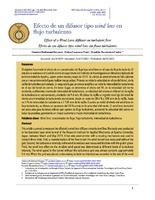Efecto de un difusor tipo wind lens en flujo turbulento
Fecha
2021-07-31Autor
Richmond-Navarro, Gustavo
Casanova-Treto, Pedro
Hernández-Castro, Franklin
Metadatos
Mostrar el registro completo del ítemResumen
El objetivo fue medir el efecto de un concentrador de flujo tipo wind lens en el caso de flujo turbulento. El estudio se realizó en el túnel de viento de capa límite del Instituto de Investigación en Mecánica Aplicada de la Universidad de Kyushu, Japón, entre marzo y mayo de 2019. Se utilizó un anemómetro de hilo caliente con un mecanismo móvil para realizar tres pruebas. Primero se mide la velocidad en el eje del túnel, sin la rejilla de turbulencia instalada. En segundo lugar, se coloca la rejilla y se mide la intensidad de turbulencia en el eje del túnel de viento. En tercer lugar, se determina el efecto del WL en la velocidad del viento incidente, a diferentes niveles de intensidad de turbulencia. La velocidad del viento en el túnel sin la rejilla de turbulencia es casi constante, alrededor de 9.6 m/s. Al colocar la rejilla se registró en el eje del túnel de viento una intensidad de turbulencia decreciente, desde un valor de 28.6 % a 500 mm de la rejilla, hasta un 5 % de intensidad de turbulencia a 3 100 mm de la rejilla. Cuando se midió el efecto del wind lens en flujo turbulento, se obtuvo un aumento del 20 % o más en la velocidad del viento. El wind lens demostró ser adecuado para turbinas eólicas que operan en flujo turbulento, acrecentó la velocidad del viento en todas las pruebas, generando un mayor aumento a mayor intensidad de turbulencia. This article is aimed to measure the effect of a wind lens diffuser on turbulent flow. The study was conducted in the boundary layer wind tunnel of the Research Institute for Applied Mechanics at Kyushu University, Japan, between March and May 2019. A hot wire anemometer with a moving mechanism was used to conduct three tests. First, a characterization of the flow inside the wind tunnel was measured without the grid. Second, the turbulence intensity in the wind tunnel axis was measured this time with the grid in place. Third, the wind lens effect on the incident wind speed was determined at different levels of turbulence intensity. The wind speed in the tunnel without the turbulence grid was almost constant, approximately 9.6 m/s. When the grid was placed, a decreasing turbulence intensity was recorded in the axis of the wind tunnel, from 28.6 % at 500 mm from the grid to 5 % turbulence intensity at 3100 mm from the grid. When the effect of the wind lens was measured on the turbulent flow, wind speed increased up to 20 %. The wind lens proved suitable for wind turbines operating in turbulent flow, by increasing wind speed in all tests and generating a greater increase in the conditions with greater turbulence intensity.
Descripción
Artículo científico
Compartir
Métricas
Colecciones
- Artículos [29]
El ítem tiene asociados los siguientes ficheros de licencia:



